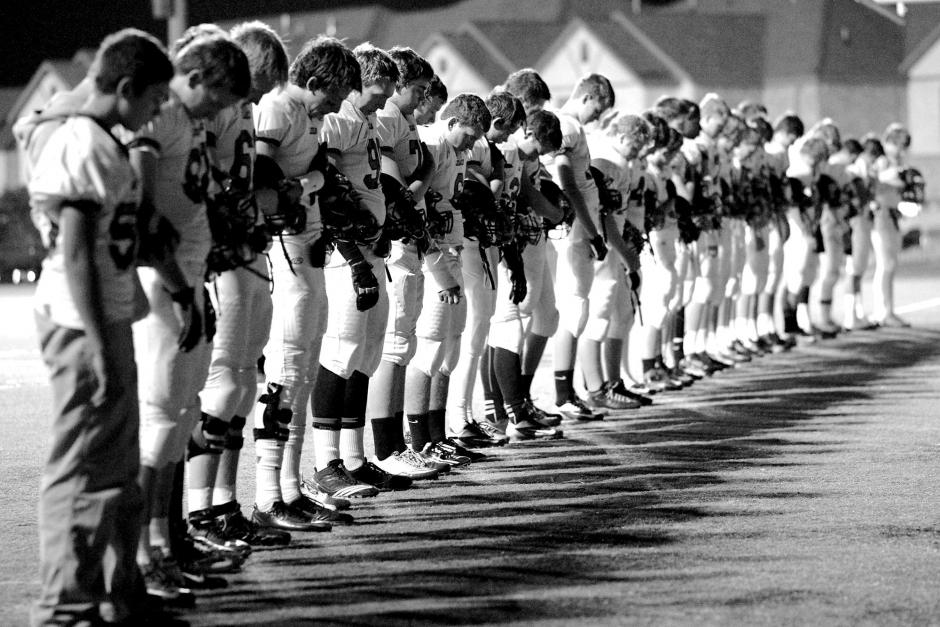Playing the Game
March/April 2020Sekulow [Jay Sekulow, founder of the American Center for Law and Justice, and now an attorney for President Trump] kept bringing cases to the Court. . . but in the 1999-2000 term he discovered the limit of his free speech arguments. The case arose out of one of the central rituals of Texas life—the high school football game.
The local school board in Santa Fe, a small town in the southern part of the state (not to be confused with the city in New Mexico), had studied the Court’s precedents with care, trying to carve out a role for prayer at the Friday night football games. Following extensive negotiations and litigation the board established a program where a student elected by his or her peers would give a “nonsectarian, nonproselytizing” prayer before each game. Nevertheless, two students, a Catholic and a Mormon, sued to stop the practice, arguing that the policy violated the establishment clause.
Sekulow, representing the school board, went before the justices with what had worked before: “Santa Fe independent school district has adopted a neutral policy which simply permits student-led, student-initiated speech at football games,” he said. The policy “allows for the individual student to determine the content of the message. That message may include a prayer at the student’s discretion. . . . The Santa Fe policy creates a venue for student expression. It is neutral as to religious or secular speech.”
This time, however, the justices looked behind Sekulow’s characterization of what was happening. The record in the case showed that the entire policy was designed by the school to allow students to lead prayers—not just “speech”—at games. “This is not a neutral speech,” Souter said to Sekulow. “It is not merely religious subject matter. It is religious worship. It is an act of religious practice.”
“And if the student decides to engage in a prayer,” Sekulow answered, “that is speech protected by the First Amendment, and to then say that a policy—”
“As private speech,” Souter shot back, “the question is whether that speech can be, in effect, involuntarily inflicted upon those who may not want it by the power of the state.”
Scalia tried to come to the rescue of the school board’s policy, but this time his bombastic style hurt his cause. He attempted to trivialize the dispute by pointing out that the two students who brought the case didn’t even use their real names, which was why the case was called Santa Fe Independent School District v. Doe. “Could I ask you about that? That’s just a curiosity I have in this case. I don’t even know who the plaintiffs are,” Scalia said. “Do people have rights to sue anonymously in federal court? Is anybody who just doesn’t want it known that he’s bringing a lawsuit, he’s ashamed of it for one reason or another, can sue anonymously?”
But it wasn’t a question of shame—it was fear. The students who had challenged the policy had been pushed, threatened, and placed in so much danger that the local judge directed that their names be taken off the complaint. That, of course, was precisely the point—that the state had harnessed the power of religious conformity to exclude outsiders.
In an opinion by [John Paul] Stevens, the Court struck down the student-led prayers in Santa Fe by a 6-3 vote, with Rehnquist, Scalia, and Thomas in dissent. The core of Stevens’ opinion was a rejection of Sekulow’s argument that the prayers were merely “private speech” by the students. “These invocations are authorized by a government policy and take place on government property at government-sponsored school-related events,” he wrote. “The expressed purposes of the policy encourage the selection of a religious message, and that is precisely how the students understand the policy.” It was no answer, Stevens continued, to say that students who were offended by prayers could simply choose to avoid the games. The school district could not “exact religious conformity from a student as the price of joining her classmates at a varsity football game.”
Sekulow was disappointed, of course, but the defeat in the Santa Fe case, combined with his earlier victories before the Court, actually wound up being a model for how the Supreme Court ought to work. The majority of the Court had settled on a reasonable and comprehensible rule for religious observances on government property—that the government had to allow genuinely private religious activity, but at the same time officials could not sponsor or endorse such rituals. After Santa Fe the Court stopped getting so many of these cases because the lower courts generally could apply these rules on their own. The Court’s compromise on the issue didn’t satisfy everyone, but it didn’t offend everyone, either—which made it a classic expression of the style of the Rehnquist Nine at this moment in history. This was not a Court for the true believers—for Scalia, Thomas, and even Rehnquist himself—but rather a Court for the middle-of-the-road majority.
Excerpted from Jeffrey Toobin, The Nine (New York: Anchor Books, 2008), pp. 148-150.
